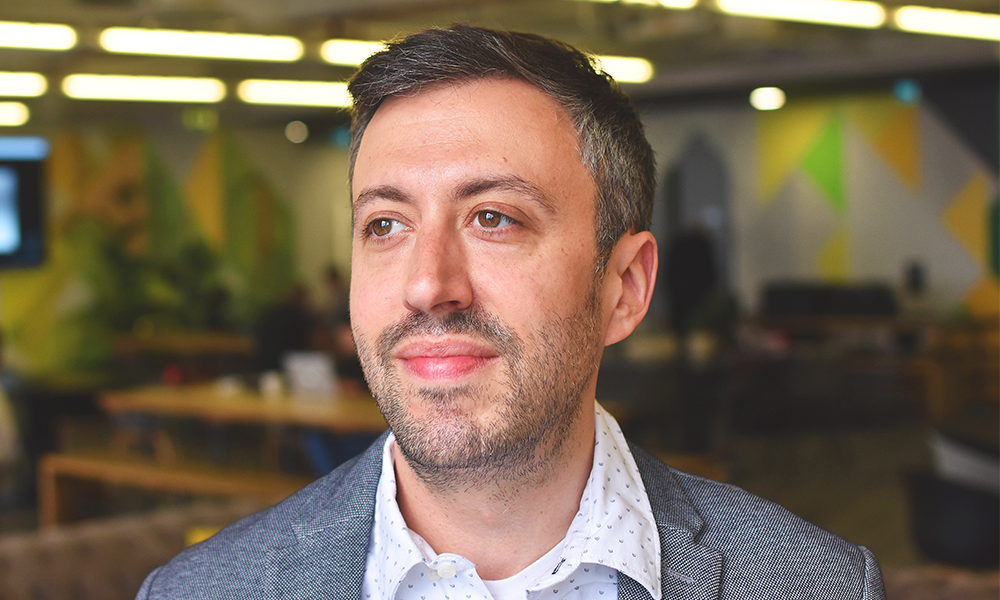Co-founder and CEO Nate Whitehill talks WordPress, websites, coins and Canary Wharf

Subscribe to Wharf Life’s weekly newsletter here
How does one become a cryptocurrency millionaire?
Since Bitcoin emerged in 2009 and investment became possible, it’s a question that’s been either idly or actively present in an increasing number of minds.
With a blizzard of coins now traded it’s a world of complexity where invention and innovation are pushing at the edge of what’s possible in terms of digital finance. Prices rise, crash and rise again.
Stablecoins lose their stability and you can be certain the next idea or gimmick is just around the corner.
For Nate Whitehill, this ever-changing story and the global thirst for information about it, has made him a millionaire in a different sense.
An entrepreneur for the last 18 years, the 38-year-old grew up just outside Seattle.
Encouraged by his grandfather and father to take business seriously, by 18 he was coding on the internet and starting ventures with his friends.
A WordPress user since 2006, by 2008 he was building blogs for corporations and discovered the joy of being able to work from anywhere remotely as well as blogging about his own endeavours.
He then went on to create Highlighter.com – a platform for students and professors to annotate individual passages of text so they could have online discussions around particular words or phrases.
“We raised about $750,000 and ran that company until 2013,” said Nate.
“By 2015 I had really discovered Bitcoin in a serious way.
“My friend in Seattle told me to download Coinbase, and the price was about $270 for a Bitcoin.
“So very early on I fell down the rabbit hole – it’s more of a black hole in the sense that people who fall into the crypto space never escape – I was on it for life.
“As I got into crypto, I started spending a tremendous amount of time on websites like Coindesk, which are like data analysis sites.
“At the time I realised I could build a version of this, combining qualitative and quantitative elements, and have everything interlinked together in WordPress.
“So I stopped the consulting I was doing at the time and started building the site – this was in 2017 and we launched in December.”
Still in Seattle at the time, Nate as co-founder and CEO of Cryptoslate rode the bull market of 2017 as prices for cryptocurrency soared and an increasing demand for information saw his site grow to about 150,000 monthly visitors.
“At this time I was also taking a really strong interest in the global implications of this technology and where previous digital innovations had happened,” said Nate.
“I could see it happening around the world, especially in places like the UK.
“So I started researching international conferences which would be interesting to attend, but then I realised there was so much happening in London and Gibraltar.
“So, in February 2018 I flew over to London and then down to Gibraltar for a fintech conference.”

Having presented at the conference, Nate found the international blockchain scene to his liking and decided to relocate to London, moving to Canary Wharf and creating a UK entity to work alongside Cryptoslate’s US business.
He said: “I came here on the endorsement of Level39’s startup visa to join Canary Wharf’s tech community.
“My view was that it contained the best of what was happening in London in an area that’s quite unlike the rest of the city.
“I fell in love with Canary Wharf, with London and with Level39 specifically, when I saw this vision of what life could be like and the opportunities that would present themselves here.
“Since I have been here, all my hopes and dreams have been exceeded in terms of the network of people I have met, so in hindsight, it’s been the best decision I have ever made.
“Having been here a year and a half, I remain passionate about London in general and Canary Wharf as a place to live – I plan on being here a long time.”
In that time Cryptoslate has grown to attract more than a million monthly readers, with Nate aiming to raise $4million to expand its operation.
“We think of the site as a crypto-discoverability engine – we have a combination of news, data and a directory,” said Nate.
“Each day we cover anything from 10 to 15 stories, created by a team of writers mostly in the western European region, but also around the world. We cover issues our audience finds compelling.
“A lot of the time it will be stories about all of the bad events happening, like the hacks and the scams, because we really want to paint an accurate picture of what’s happening with cryptocurrency.
“We don’t think of ourselves as trying to sell ‘hopium’ – the idea people will feed nonsense to each other with the hope of making short-term gains through investment.
“Something that makes us unique compared with other coin sites is that we combine the qualitative and the quantitative to give readers a more accurate picture.
“When you go to a Cryptoslate article about Bitcoin, for example, you’ll not only see the content of the article, you’ll also see a press chart about what Bitcoin actually is, with the opportunity to click through and learn more about it from a qualitative perspective.
“We also do that with our directory of people, products, companies, places and events.
“We also have a strict conflict-of-interest policy, so any time a writer holds an asset they are writing about, they have to check a box and there’s a disclaimer at the bottom of the article. The goal is always to be as transparent and honest as possible.
“I am not editorially involved, personally – I’m a step away – but we don’t discourage our writers from investing in crypto.
“In fact, we think that, if people are using the products, they have a better understanding of how to accurately depict them.”

Cryptoslate is actively looking both for strategic investors and to hire writers in London as it grows. It gets about 90% of its revenue from advertising, while 10% comes from its subscription service.
Cryptoslate Edge offers greater analysis, longer stories and is designed to give global investors a better understanding of the market.
“We always try to discourage trying to tell anyone what they should buy, what is a good or bad investment decision, trying to be as objective as possible, but doing it in a more comprehensive way through CryptoSlate Edge,” said Nate.
“The idea behind cryptocurrency is to create an alternative financial system for the world, and that’s absolutely coming true.
“Increasingly the traditional financial system is figuring out ways that it can participate in the crypto economy.
“Just the other day Fidelity announced that it would be offering Bitcoin in pensions, for example.
“Increasingly the crypto industry is going to become part of our daily lives over the next decade.
“People will be using different decentralised protocols and crypto currencies without even realising.
“In the same way that someone may not understand how the internet works, but will use Facebook and Instagram, so it will be the same with crypto technologies over the next decade.
“In five years you could pay by scanning a QR code which connects to your Bitcoin wallet and that’s how you pay for something. These are just some of the things that will be huge for society.”
And Cryptoslate will be there to help its readers and subscribers navigate that future.
Read more: Cody Dock tests its rolling bridge
Read Wharf Life’s e-edition here
Subscribe to Wharf Life’s weekly newsletter here
- Jon Massey is co-founder and editorial director of Wharf Life and writes about a wide range of subjects in Canary Wharf, Docklands and east London - contact via jon.massey@wharf-life.com






